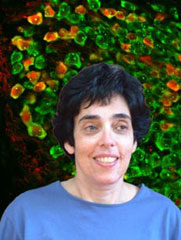Department of Anatomy and Neurobiology
 Detlef Heck, Ph.D.
Detlef Heck, Ph.D.
The research project will use automatic video tracking technology for a detailed quantitative investigation of social and motor behavior in normal mice and mouse models of heritable brain disorders (autism and ataxia). The goal is to identify quantifiable deficits in complex social and simple motor behaviors in mouse models of human brain disorders. The project involves the handling of mice, performance of behavioral tests, recording of the video data and analysis of the data using statistical analysis software packages (Sigmastat, SPSS or SAS). All activities will be performed in under the supervision of the PI (Dr. Heck).
 Matt Ennis, Ph.D.
Matt Ennis, Ph.D.
My primary interests are centered on the functional organization and physiological properties of neural networks involved in nociception/analgesia processing and the chemical senses (i.e., olfaction and gustation). My research utilizes an integrative, multidisciplinary approach combining tract tracing, immunocytochemistry, immediate early gene expression and electrophysiology to delineate cellular and circuit properties of functionally defined networks. Additional details can be found on my websites:
http://www.hayar.net/EnnisLab/
The major current projects in my laboratory are:
Regulation of Brainstem Opioid Analgesic Circuits. A well defined brainstemspinal cord circuit is known to play a key role in opioidmediated analgesia. We are investigating how higher levels of the CNS (cortical and subcortical sites) involved in emotions, motivational state and cognitive processing can regulate this brainstem analgesic circuit to allow for statedependent modulation of pain thresholds. We are also investigating how sweet and fatty components of mothers milk produces profound opiate receptordependent analgesic and calming effects in newborn rats and humans.
Synaptic Integration and Information Processing in the Olfactory Bulb.
We are investigating how neuronal membrane properties and extrinsic/intrinsic neurotransmitter systems modulate information processing and output from the olfactory bulb circuit using functional imaging and neurophysiology approaches in vivo and in vitro.
Integration in the Olfactory Bulb (OB)Piriform Cortex (PC) Circuit. Olfactory receptor neurons that express a single common odorant receptor project to one glomerulus in the OB. The glomeruli thus form a map that mirrors receptor activity. Different odors stimulate different patterns of glomerular activity. The OB and PC comprise the major components of the neural network that decipher such patterns to arrive at the recognition of an odor. The goal of this research is to understand how glomerular activity is relayed to, and processed within PC using neuroanatomical and neurophysiological approaches.
 Kristen Hamre, Ph.D.
Kristen Hamre, Ph.D.
Research Interests:
Depending upon the interest of the student, there are two possible types of techniques that a student could learn. One is that the student could learn about behavioral testing of mice to examine both baseline and alcoholmediated behaviors that measure such parameters as anxiety and balance/ coordination. Second, through the analysis of development a student could learn techniques such as genotyping through the use of PCR and histological processing of tissue.
 Marcia Honig, Ph.D.
Marcia Honig, Ph.D.
Research Interests:
My laboratory investigates how axons choose the correct pathways to grow along during development. We use the chick embryo as a model system because its accessibility allows us to perform experimental manipulations at virtually any point during embryonic development. Our work focuses on sensory neurons innervating the hindlimb and has shown that sensory neurons whose axons project along different peripheral nerves are different from one another at very early stages, before they make specific pathfinding decisions. Further, sensory axons respond to specific cues on one another and in the environment as they extend into the limb and grow to their appropriate targets.
Our recent surgical manipulations have shown that the initial formation of a major cutaneous nerve in the embryonic chick limb requires the presence of the target ectoderm during a critical time period when those axons are about to diverge from the hindlimb plexus. We subsequently demonstrated that BMP4, which is expressed in a discrete region of the limb, promotes cutaneous nerve formation. Current work in the lab is primarily aimed at determining how BMP4 signals sensory axons (i.e. directly or indirectly), and elucidating the molecular mechanisms underlying BMP4 action. To do this, we are employing a loss of function approach, in which shRNA constructs are transfected into cells, subsequently leading to the downregulation of the protein(s) of interest, focusing initially on the major receptors for BMP4.
In addition to a variety of molecular biological techniques, work in the lab involves the use of multiple labeling approaches (retrograde labeling, immunofluorescence, in situ hybridization), in conjunction with confocal laser scanning microscopy.
Tony Reiner, Ph.D.
Research Interests:
The work in this laboratory focuses on the organization, function, and diseases of the basal ganglia and visual system, and on the evolution and fundamental organization of the vertebrate forebrain.
With respect to basal ganglia organization and function, we are exploring the neural substrate by which different types of cortical and basal ganglia neurons differ in their role in movement control. We are particularly interested in whether different types of cortical
neurons communicate with different types of basal ganglia neurons to mediate different aspects of movement control. To address such issues, we use LM and EM labeling methods (pathway tracing, immunohistochemistry and in situ hybridization) in various combinations to determine the neurotransmitters used by specific cells types, the inputs and outputs of those cells types, and the receptor mechanisms involved in those inputs and outputs.
In our work on basal ganglia disease, we study the means by which the gene mutation in Huntington′s disease leads to selective destruction of neurons in the striatal part of the basal ganglia. We use experimental animal models and genetically engineered mice, and we have been particularly interested in the possibility that the mutation perturbs the function of cortical neurons projecting to striatum so as to render them injurious to their target striatal neurons. This injury process could involve excess glutamate release from corticostriatal terminals or diminished production by corticostriatal neurons of neurotrophic factors needed for survival by striatal neurons. In our work on the visual system, we are interested in the neural mechanisms by which blood flow in the choroid of the eye is adaptively controlled according to retinal need and in the role disturbances in such neural control may play in agerelated decline in retinal function.
Finally, we have a longstanding interest in the evolution of the cerebral cortex, basal ganglia, and thalamus, and in how these structures differ among birds, reptiles and mammals. In our studies, we use neurochemistry, hodology and the localization of developmentally regulated genes to characterize the organization of these regions and ascertain the course evolution has taken.
Department of Neurology
 Lawrence T. Reiter, Ph.D.
Lawrence T. Reiter, Ph.D.
Research Interests:
My laboratory utilizes the powerful genetic model organism Drosophila melanogaster (fruit flies) to investigate the functions of genes involved in human neurological disease. Our main focus is the study of genes related to autism and autism spectrum disorders. Autism spectrum disorders include the severely debilitating Rett syndrome (RTT) and Angelman syndrome (AS). These disorders are interrelated at the molecular level and mutations in the gene that causes RTT can also cause AS. In addition, approximately 3% of all
inherited autism cases may result from maternally inherited duplications of the region containing the gene that causes AS, UBE3A. Mutations in the protein targets of the ubiquitin ligase UBE3A or the transcriptional regulator MECP2 may, therefore, account for a significant percentage of inherited autism cases as well.
In our laboratory we utilize Drosophila specific genetic techniques that allow us to generate artificially high levels of normal and mutant fly ube3a proteins in fly heads. Wild type, dominant negative and epitope tagged forms of ube3a are overexpressed in the brains of flies using the GAL4/UAS system in order to increase or decrease the levels of ube3a protein targets. We then identify these targets by 2D gel electrophoresis and mass spectrometry (proteomics). Potential targets will be validated though genetic suppressor/enhancer screens, immunoprecipitation binding assays in 293T cells and immunohistochemistry in the brains of the appropriate mouse models.
We have also been working in the Drosophila embryonic nervous system and larval neuromuscular junction to determine the normal expression patterns of UBE3A targets as well as how these proteins are regulated by UBE3A expression or loss of function in neurons. Our long term hypothesis is that synaptic plasticity in postmitotic neurons, which requires ubiquitination, is regulated and or executed by the genes transcriptionally repressed by MECP2 and the post translationally modified proteins ubiquitinated by UBE3A. The identification of these target genes may also prove useful in the future, since they may be appropriate therapeutic targets.
 Shalina Narayana, Ph.D.
Shalina Narayana, Ph.D.
Research Interests
My research is centered on two main areas: 1. Optimizing the clinical application of non-invasive brain imaging and stimulation methods in diagnostic and therapeutic domains, and 2. Characterizing functional characterization of the speech and limb motor networks and disease, injury, and treatment induced plasticity in these systems. These research objectives are focused around human speech and motor systems and use multimodal neurophysiological imaging methods. The neuroimaging methods used include magnetoencephalography (MEG), Transcranial magnetic stimulation (TMS), and functional magnetic resonance imaging (fMRI).
Ongoing research projects include examining the therapeutic effects of TMS in speech and voice disorders in Parkinson's disease, and epilepsy. Other studies include developing population normative data of TMS derived neurophysiological parameters and optimizing non-invasive brain stimulation and functional imaging in the context of presurgical mapping.
The lab is also investigating functional connectivity of speech and limb motor systems. Studies are also characterizing changes in the speech motor system resulting from Parkinson's disease and the compensatory adaptations in the network following voice treatment as well as identifying neurophysiological correlates of performance enhancement resulting from motor training and adjuvant TMS.
Patients with Parkinson’s disease suffer from voice and speech deficits that significantly impede communication, productivity and overall quality of life. The most effective current treatment for Parkinson’s hypophonia is Lee Silverman Voice Treatment (LSVT), a behavioral therapy based on the Hebbian principles of motor learning and neural plasticity. Taking advantage of complimentary mechanisms of action of LSVT and transcranial magnetic stimulation (TMS), we are testing the efficacy of facilitatory TMS as a treatment adjuvant with LSVT in a longitudinal randomized controlled study. Patients are assessed at baseline, immediately post-treatment and at a 3 month follow up with a battery of perceptual and acoustic measures of voice and speech. In addition, we are investigating the changes in brain activation and functional connectivity, and anatomical connectivity within the components of the speech motor network using functional magnetic resonance imaging and diffusion tensor imaging. The project involves learning the basics of TMS, MRI and voice and speech assessments. The student is expected to analyze functional MRI and diffusion tensor imaging data using various image analysis tools. The student must have fundamental knowledge of neuroanatomy and excellent analytical skills.
Department of Pharmacology
 Alex Dopico, MD, Ph.D.
Alex Dopico, MD, Ph.D.
Research Interest:
My laboratory is interested in determining the mechanism of action of small amphiphilic compounds on ion channels from excitable cells. One of these amphiphiles is alcohol, the most widely used and abused drug. Some others are physiological modulators, such as bile acids and neurosteroids. Our current research is focused on two projects dealing with large conductance, Ca++activated K+ (BK) channels. These channel proteins have been demonstrated to be involved in both controlling central neuron excitability and regulating arterial smooth muscle tone.
Project 1: To determine the molecular
basis for differential actions of alcohol on BK channels from mammalian brain vs. arterial smooth muscle, including modulation of drug action by membrane lipids. Project 2: To determine the structural requirements (both in the amphiphile molecule and the ion channel protein) for the modulation of arterial muscle BK channels by bile acids.
For these studies we combine electrophysiological and molecular biology techniques. Ion channel responses to drug exposure are evaluated in: 1) freshly isolated cells, where we study drug modification of channel behavior in the native environment of the channel protein; 2) isolated patches of cell membrane, where we can address the differential role of different membranebound vs. cytosolic second messengers in drug action; 3) artificial bilayers of controlled lipid composition, where we can determine the modulatory role of membrane lipids in drug action.
Ion channel isoforms from relevant tissue are identified. Following mRNA isolation and cloning, channel subunits of known sequence are expressed in heterologous systems such as Xenopus oocytes or HEK293 cells. Then, we can determine the role of channel subunit composition in drug action by studying drug effects on ion channel complexes that differ in poreforming and/or modulatory subunit composition. In addition, differential responses to a drug by channels that differ in a given region of a subunit, when studied in the same proteolipid environment, allow us to postulate sites in that subunit for drug recognition. This is probed by studying drug action on expressed channel proteins that include mutations in the postulated region(s).
My laboratory is interested in determining the molecular mechanism of action of alcohol and other small amphiphiles on ion channel proteins from the brain and arterial vessels. To determine the recognition sites for alcohol in these proteins and how alcohol modifies protein function upon interaction with these sites, will provide critical information for understanding how the drug interacts with its targets and, eventually, lead to the design of clinically useful agents to treat conditions associated with alcohol intake.
 K. U. Malik, Ph.D., D. Sc.
K. U. Malik, Ph.D., D. Sc.
The overall objective of our research is to elucidate the cellular and molecular signal transduction mechanisms of growth factors, circulating hormones including angiotensin II (Ang II) and locally generated autacoids (eicosanoids) and adrenergic transmitter norepinephrine (NE) in the regulation of cardiovascular function in health and in the development of hypertension and vasculopathy associated with restenosis, atherosclerosis and diabetes. Our studies should further our knowledge of the neurohumoral mechanisms that regulate vascular function and its alteration in vascular diseases. Moreover, these studies should allow formulating rational approaches
for the development of novel therapeutic agents for the treatment of hypertension, arteriosclerosis and restenosis.
We use isolated cultured vascular smooth muscle and endothelial cells, isolated perfused organs (heart, kidney and blood vessels), wire myogrph for measuring vascular reactivity models of hypertension (Ang II and DOCASalt and SHR), balloon injured carotid artery and now we are also transgenic animals for our studies. The laboratory techniques also include the use of HPLCGCMass spectrometric Analysis of Eicosanoids, SDAPAGE and Western blot analysis, DNA and RNA isolation, purification and quantitation, PCR, RTPCR, QPCR, DNA transfection in cells Plasmid preparation, restriction fragment mapping, Construction of siRNA of various signal molecules, Transfection of reporter vectors as well as overexpression of constitutively active or dominant negative proteins, Coimmunoprecipitation and colocalization techniques, confocal microscopy, site direct mutagenesis Molecular imaging of protein interactions Immunoassays and protein analysis, insertion of miRNA into adeno, lenti and adenoassociated viral vectors and preparation of viruses for transfection in cultured cells and for in vivo use. The signaling molecules studied by ELISA, in vitro kinase assay and Proteomics include, RasGTPas, ERK1/2, MEK, Raf, p38MAPK, c JNK, PI3 kinase, Akt, JAKSTA, Pyk2, cSrc, Syk and EGF.
 Fu-Ming Zhou, Ph.D.
Fu-Ming Zhou, Ph.D.
Research Interest:
Dr. Zhou currently conducts a multidisciplinary research program designed to determine the molecular, cellular and neuropharmacological mechanisms of the brain monoamine systems. Particular attention is being paid to the contributions of these monoamine systems to neuropsychiatric disorders such as Parkinson’s disease, depression, schizophrenia, drug abuse, and attention deficit hyperactivity disorder (ADHD). We use rodents as our experimental animals. Mutant mice are also used.
Several techniques are used in the laboratory:
- Electrophysiologypatch clamp
- Single cell RTPCR (in combination with patch clamp)
- Electrochemistry (fast cyclic voltammetry at the carbon fiber microelectrode; HPLC)
- Immunohistochemistry
Dr. Zhou’s research is funded by R01 grants from the National Institute on Drug Abuse and National Institute of Mental Health and grants from private foundations.
 Anna N. Bukiya, Ph.D.
Anna N. Bukiya, Ph.D.
Research Interests:
The major line of interest in the lab is the lipid regulation of alcohol effect on cerebral circulation at different points during lifetime (from in utero into late adulthood). We are currently pursuing several lines. We are studying the role of dietary cholesterol in the physiology and pathology of cerebral arteries via ion channel involvement. Using rat model of high-cholesterol diet, we were the first to show that dietary cholesterol was a critical nutritional regulator of alcohol-induced constriction of cerebral arteries. After establishing the phenomenon at organ level, we are currently dissecting out molecular and structural mechanisms that enable cholesterol regulation of alcohol-induced constriction of cerebral arteries. Considering that statins - cholesterol lowering therapy - are one of the most widely prescribed and consumed drugs, we are studying their effect on cholesterol level in cerebral artery tissue and on artery response to alcohol.
Another line of work is carried out in close collaboration with the Department of Comparative Medicine and with the Department of Obstetrics and Gynecology at UTHSC. This line of work involves non-human primates - baboons, whose pregnancy and developmental milestones are similar to humans. We are focused on the role of endocannabinoid lipids in alcohol effect on fetal cerebral circulation during maternal binge drinking. We are aiming at identification of novel targets of maternal drinking in fetal cerebral arteries. This exploratory work may lay a foundation to early diagnostics and successful prevention/treatment of the fetal alcohol spectrum disorders (FASD) and fetal alcohol syndrome (FAS) that are estimated to affect at least 1% of births in the USA.
In addition, we are working on the interaction of potassium (e.g. GIRK, BK) channels with physiologically relevant lipids. In close collaboration with Dr. Alex Dopico (UTHSC), we were able to map several lipid-sensing sites in both BK channel-forming and accessory beta 1 subunits. These studies include recognition motifs for bile acids, cholesterol, and leukotriene B4. We are currently working on developing synthetic ligands for these sites. Newly discovered ligands will be used as lead compounds for designing drugs that modulate diameter of cerebral arteries via action on BK channel. In another collaborative line with Dr. Avia Rosenhouse-Dantsker at the University of Illinois at Chicago we are studying molecular mechanisms of cholesterol modulation of GIRK channels and potential implications of such modulation on GIRK channel physiology and role in Down syndrome pathology.
Department of Physiology
 Ioannis Dragatsis, PhD
Ioannis Dragatsis, PhD
Project 1 Title: Analysis of a mouse model for Familial Dysautonomia
Familial Dysautonomia (FD) is an autosomal recessive disorder that affects 1/3,600 live births in the Ashkenazi Jewish population, leading to death before the age of 40. The disease is characterized by progressive degeneration of the sensory and autonomic nervous system. Despite the identification of the gene that causes FD (Ikbkap) and recent medical advances, no cure is available. We have generated a mouse model recapitulating the phenotypic features of the disease and our goal is to elucidate the mechanisms that lead to neuronal degeneration in FD and to test therapeutic strategies.
Project 2 Title: Analysis of the function(s) of huntingtin
Huntington’s disease (HD) is an autosomal dominant disorder that affects 1 in 10,000 individuals. HD is characterized by chorea, rigidity and progressive dementia. Symptoms usually begin between the ages of 35 and 50 years, with death typically following 15 to 20 years later. HD is caused by the expansion of an unstable stretch of CAG triplet repeats within the coding region of the HD gene. Moreover the protein encoded by the HD gene, huntingtin, is a novel protein of unknown function.
We are using the mouse as a model organism. Inactivation of the mouse homologue of the HD gene results in embryonic lethality demonstrating that huntingtin is essential for early embryonic development. Conditional inactivation of the gene at later stages results in progressive neurodegeneration in the adult mouse, suggesting that huntingtin is also essential for neuronal survival.
 Charles W. Leffler, Ph.D.
Charles W. Leffler, Ph.D.
Research Interests:
We employ a multitude of techniques from intravital microscopic studies of cerebral circulation in vivo, to subcellular imaging, molecularcellular approaches, biochemistry and even chemistry. So it completely depends on the student what kinds of techniques are involved. Most tend to want to do in vivo cranial window studies.
Research in the laboratory concentrates on control of cerebral
circulation.The primary focus of this research involves autocrine/paracrine control of the newborn cerebral microvasculature during physiologically stressful and pathological situations, and the cellular mechanisms involved in such control. We investigate autocrine and paracrine communication within the vessel wall, with specific current focus on the novel gasotransmitters, carbon monoxide and hydrogen sulfide.